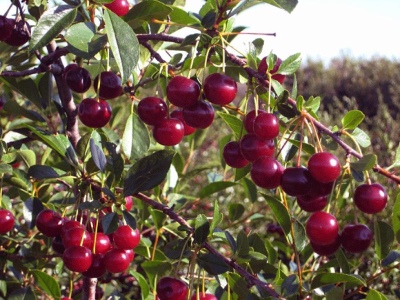
- Authors: Canada
- Name synonyms: Carmine Jewel
- Barrel type: bush
- Growth type: medium-sized
- Flowers: average
- Fruit size: large
- Fruit shape: rounded
- Fruit color: red
- Fruit weight, g: 5
- Pulp (consistency): juicy
The common cherry variety Carmine Jewel obtained by Canadian breeders also managed to conquer Russian gardeners. Its shape is close to that of a shrub, even an adult plant takes up little space, looks very decorative and attractive. The variety is perfectly adapted to the continental climate, in colder regions it successfully tolerates frosty winters.
Description of the variety
The trunk of the Carmine Jewel cherry develops as a shrub type. Plants are medium in size, up to 2 m tall, sometimes referred to as dwarfs. Plants with a compact crown, not too spreading. Moderate foliage, does not interfere with the ripening of fruits on the branches. The flowers are snow-white, fragrant, not very large.
Fruit characteristics
The fruits do not crumble, they are firmly held on the branches. Cherries are large, with an average weight of about 5 g, regular round shape. The fruit has a rich carmine-red color and is very beautiful during ripening. The bone is small inside, there are no problems with its separation. Fruits are successfully stored fresh for up to 3 weeks; due to their dense skin, mechanized harvesting is possible.
Taste qualities
Cherries are intended for fresh consumption. Juicy pulp with sweet and sour pleasant taste is perfect for making desserts. The dense skin helps to keep cherries in their original form when frozen or canned, without crushing, does not spoil the taste of the fruit. In ripe cherries, it is maroon. The taste of the pulp is devoid of astringency, it is truly rich, accompanied by a pleasant aroma.
Ripening and fruiting
Carmine Jewel begins to bear fruit for 3-4 years, from that moment it gives a harvest annually. The medium ripening period allows the berries to ripen on the branches before being removed. The fruiting period lasts about 2 weeks, from 15 to 30 July.

Yield
Carmine Jewel has high yields. From 1 tree, 18-20 kg of ripe fruits are harvested. By 7-8 years after planting, you can expect the most bountiful harvests.
Growing regions
Cherry Carmine Jewel bred in the Canadian harsh continental climate. In the Russian Federation, they also try to plant it in regions close to ideal growing conditions. In Central Russia, yields will be lower. The variety is picky about the amount of sun; in regions with a predominance of cloudy weather, record harvests are also not to be expected.
Self-fertility and the need for pollinators
The tree is covered with flowers in May. Carmine Jewel is a self-fertile variety that does not require cross-pollination. This cherry can be the only one in the garden without compromising its fruitful qualities.
Landing
The seedling does not need a lot of space, it is enough to maintain a distance of 1.5-2 m relative to other plants and buildings. Place it in a well-lit space bathed in the sun. For mechanized harvesting in gardens, at least 5 m is left between cherry trees.


Growing and care
The shrub shape of the trunk and crown requires regular pruning. Carmine Jewel gives a fairly abundant growth of shoots, so cherries are formed, and in the spring they also remove dry, frozen branches. At the same time, you can feed the tree by loosening the trunk circle beforehand. The best fertilizer will be rotted manure, 20-30 kg at the root.
The plant does not need constant watering. But in the autumn months, during the period of leaf fall, it is necessary to produce moisture-charging humidification. 4-5 buckets of water are added under the root at the same time.


Disease and pest resistance
Carmine Jewel has a high general protection against the influence of parasitic insects, fungi and infections.
Requirements for soil and climatic conditions
Carmine Jewel belongs to varieties with high winter hardiness. Cherry trees successfully withstand frosts down to -40 °. In the choice of soil, loam is preferable.

Review overview
Summer residents speak very well of the Carmine Jewel cherry variety. Low-growing bushes greatly facilitate the harvesting process, and the fruits themselves have an excellent taste. Confectioners and dessert masters are especially fond of it. It is noted that even without other cherries or cherries in the garden, you can get a harvest. Otherwise, Carmine Jewel also does not fail, tolerates frost and drought well, and is almost not affected by fungal diseases.
The disadvantages of the variety include a long wait until really bountiful harvests are obtained. Fruits fully ripen only by mid-August. Outside the continental climatic zone, yields drop significantly.































































